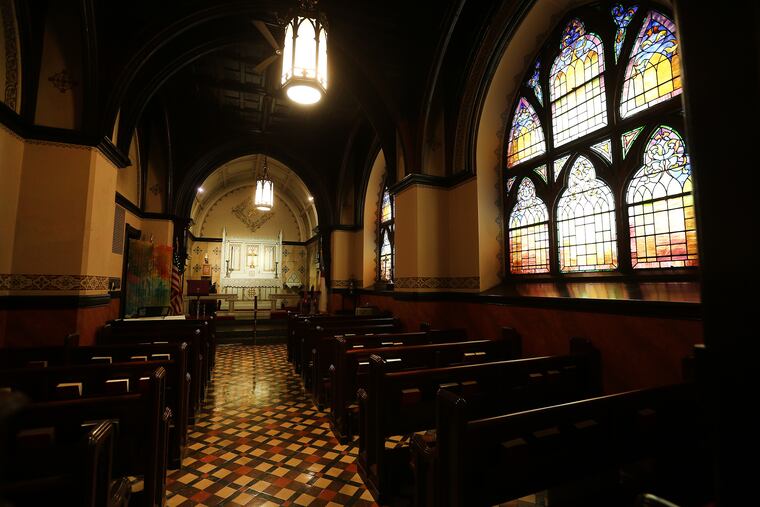Could a parking garage ruin an iconic church on a Pennsylvania mountain?
Finished in 1869, St. Mark’s and St. John’s Episcopal Church is an iconic building in downtown Jim Thorpe, Carbon County.

Editor’s note: An earlier version of this story had an incorrect first name for Louis Comfort Tiffany.
JIM THORPE, Pa. — No one is quite sure how much the large Tiffany window is worth, but when the sun sweeps into the valley and illuminates the stained glass and precious stones embedded in it, the value moves from “probably a couple of million” to priceless.
If something were to shake the foundation of St. Mark’s and St. John’s Episcopal Church, a national historic landmark built literally into a mountain, and shatter the glass that Louis Comfort Tiffany installed himself in 1895, the appraisal would be much easier. It would be worth nothing, along with any of the 60 other Tiffany windows there.
“This is the window that is most in danger,” caretaker Mary Shorten said of the 10-by-18-foot centerpiece.
The threat, she and other Jim Thorpe residents said, is a $13-million construction project adjacent to the church that would include offices for Carbon County and a parking garage for its employees. Construction was to begin soon but has been delayed by legal action the church has taken.
Parking is a rare commodity on the hilly, narrow streets of Jim Thorpe, a former coal town that renamed and reinvented itself as a tourist destination over the last 50 years. Originally known as Mauch Chunk, it is is home to bed and breakfasts, concert venues, museums, pubs, and boutiques.
But Jim Thorpe, population 4,633, is also the county seat, and that means there aren’t just tourists circling endlessly for parking.
“There’s a parking problem here, and we have to be in walking distance to the courts,” said Wayne Nothstein, a Carbon County commissioner. “It’s going to be a block or two from the courthouse.”
Nothstein said the commissioners did seek out other properties to build the parking garage and offices, but none worked out. Public transportation, he said, is one of the county’s biggest headaches, which means that for everyone who comes in and out for court, driving is the only real option.
“We would have like to have gone elsewhere,” he said.
Nothstein said the project will take every precaution with the church, noting that dynamite wouldn’t be used to excavate rock. The county, he said, also has hired a company to do vibration monitoring and increased its insurance “in case something happens.”
“What else can we do to eliminate their fears?” he said. “They’ll have that fear no matter what we do.”
Instead of stairs, congregants can get to the church via a large, open-air Otis elevator installed by Mary Packer Cummings, one of the world’s wealthiest women in the late 19th century. Daughter of Asa Packer, a Mauch Chunk resident and founder of Lehigh University, she was heir to the family’s fortune.
Packer Cummings vowed to be the first person to ride the elevator, and she was — in her casket, after she died in 1912.
“There was no expense spared on this building,” Shorten said.
As the church’s fortunes grew under King Coal, the windows were added. Its most interesting feature, however, might be in the basement, where one wall isn’t really a wall at all. It’s the side of Flagstaff Mountain. In spring, when the ice thaws on the mountain, water seeps through the rocks in the church. Designed by architect Richard Upjohn in 1869, the church is so integrated into its environment that supporters fear the rock could shift and slide during the county’s project, damaging much more than glass.
“It’s one whole mass of rock and stone and dirt that’s been living together for a long time, and if you interfere with that, you’re asking for trouble,” said John Drury, owner of the nearby Inn at Jim Thorpe.
Betty Lou McBride, a resident who owns the historic Carbon County Jail up the street, believes banking on an insurance policy to safeguard the project is shortsighted.
“They say, if there’s a problem, that they’ll stop. but there’s no next sentence,” said McBride. “Is it, ‘We’ll stop the job and go home? We’ll give it up. We’ll start using nail files?’”
When the borough council granted conditional approval for the project in February, the church filed a lawsuit against the borough. Shorten claims the church has received letters from architects and statewide historical commissions supporting its efforts to halt the project.
The lawsuit alleges the project will mean “immediate and irreparable harm to the historic structures and fixtures.”
Members of Jim Thorpe’s borough council did not return a request for comment. Nothstein said he could not comment on the group’s lawsuit.
The church has approximately 150 people on its rolls, but fewer show up for Mass each week. A “Save Our Church & Town” GoFundMe has been created, with $1,285 of its $10,000 goal raised so far. Shorten said some of that money has gone toward hiring the congregation’s own structural engineer to study the project, and they’re waiting for his report to be done. In the meantime, she said, she’s ready to oppose the bulldozers and jackhammers in person, on the mountain.
“I’ll stand out there,” she said. “We will stand out there and stop them from proceeding until the proper things are done.”